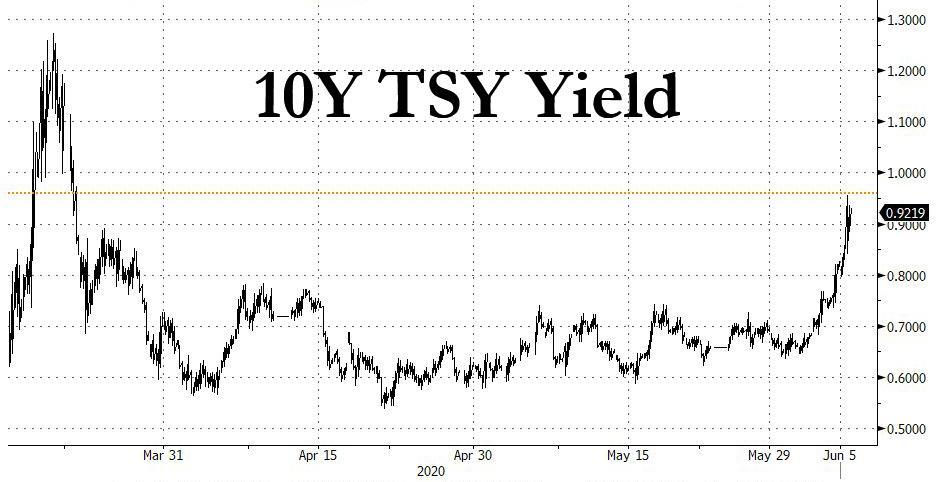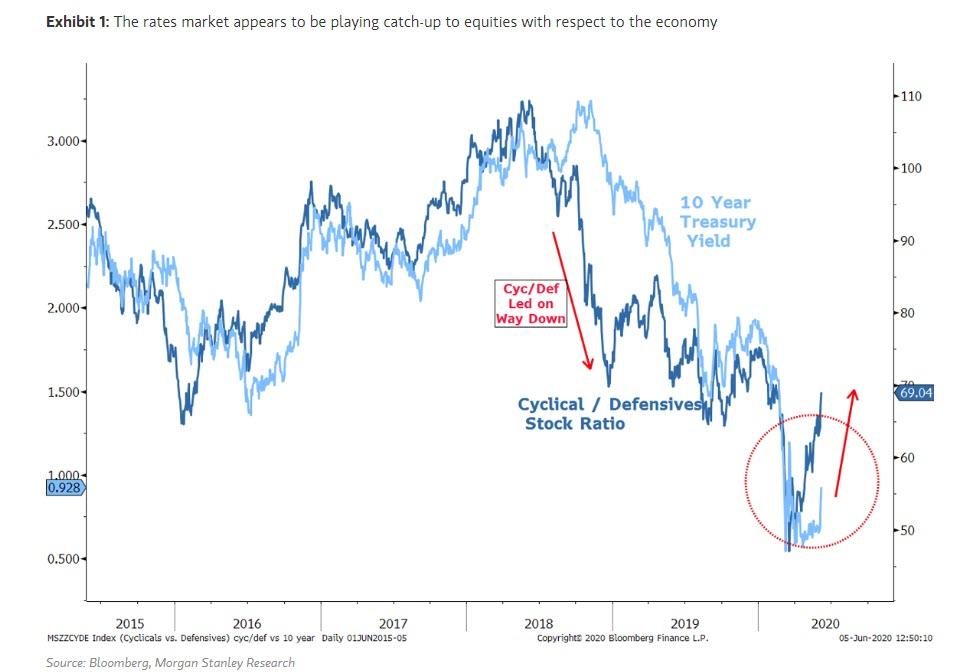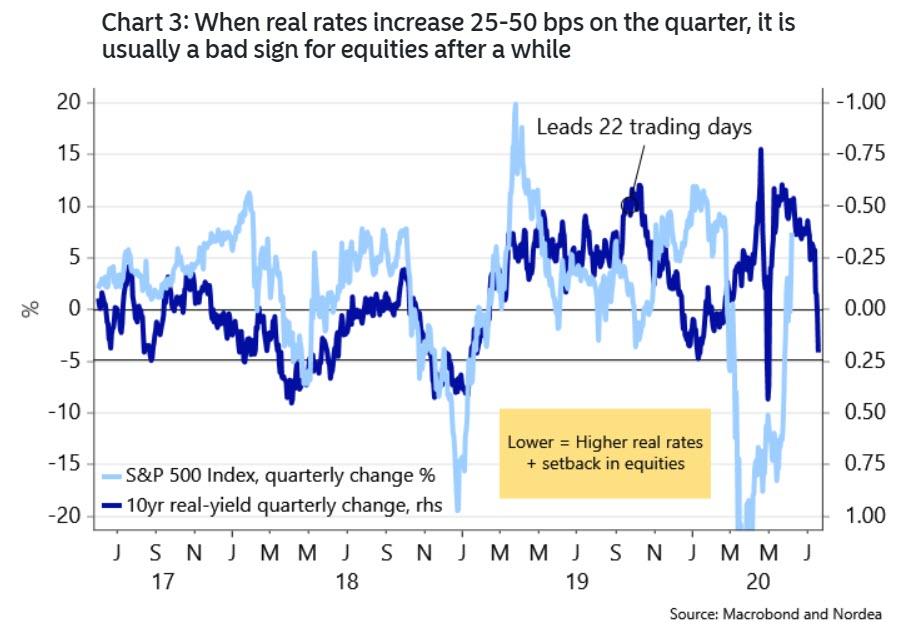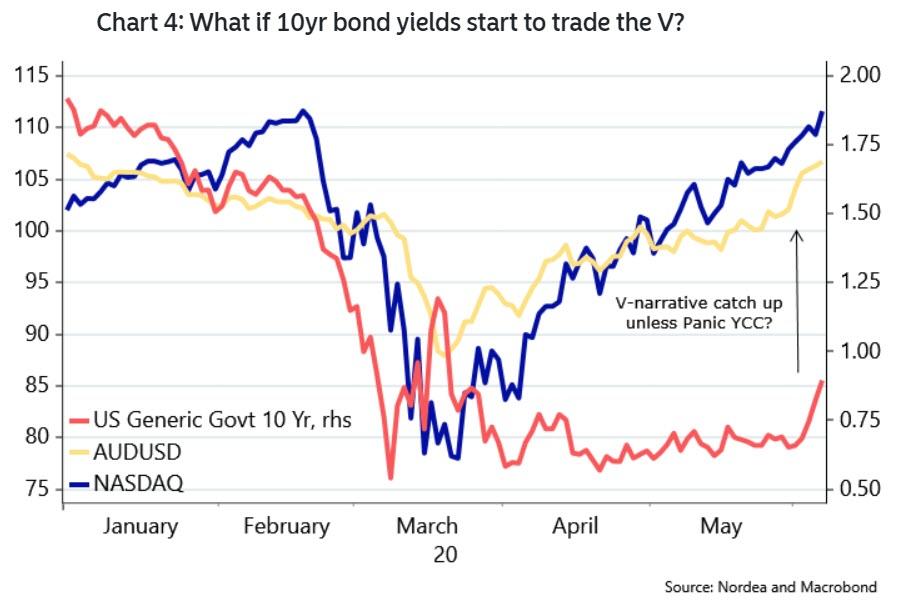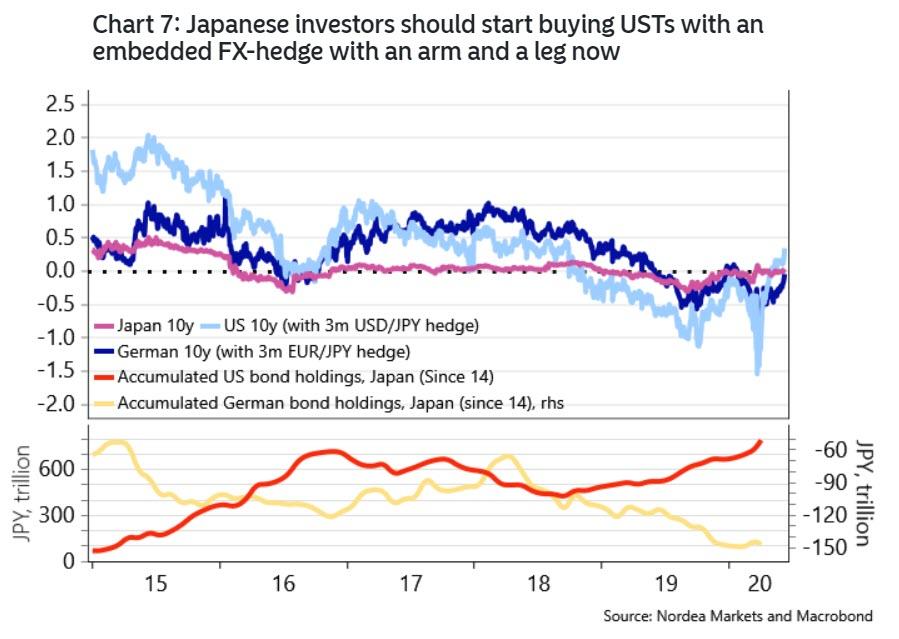“A Sudden, Sharp Spike In Yields Will Cause A Stock Market Correction”
Tyler Durden
Sun, 06/07/2020 – 18:00
Last week, as traders were transfixed by the latest surge higher in stocks, the real move was elsewhere as 10Y yields finally broke out of the narrow range in which they had been trading for the past two months.
The breakout prompted BofA CIO Michael Hartnett to warn on Friday that the next “extreme move” will be in Treasuries, noting that the “biggest summer pain trade is disorderly rise in government bond yields“, with the 30Y rising toward 2%, and the 10Y passing through 1%.
The problem is that such sharp, “VaR-shocking” moves higher in yields, which lead to substantially tighter financial conditions, don’t happen in a vacuum and traditionally hit risk assets as Morgan Stanley’s Michael Wilson warns in his weekly “Sunday Start” piece titled aptly, “Rates Play Catch-Up, Again.”
In his latest note, Wilson starts off by first laying out the five reasons he has been bullish since March:
- Bear markets end, rather than begin, with recessions
- The health crisis that triggered this recession has brought unprecedented monetary and fiscal stimulus that would otherwise have been impossible
- The political pressures behind the reopening of the US economy are likely to make it faster and more durable, even if a second wave of the virus emerges
- Sentiment and positioning have remained remarkably bearish considering the size and persistence of the equity rally; and
- Index prices, the equity risk premium, market breadth and early-cycle leadership are all following the pattern seen after the 2009 bottom.
Wilson also noted that several signals which would support a continued bullish outlook for equities, have been missing, namely: i) the US dollar has remained strong as ii) 10-year Treasury yields continue to be depressed.
While one could argue that a strong US dollar benefits US equity markets through flows and lower rates support valuations, our contention is that both are bad signs for inflation and the overall economic recovery. Therefore, we were glad to see both a weaker dollar and higher back-end rates last week even before the stronger jobs data were released on Friday. In fact, both have moved above some key resistance levels left over from April. This combination provides the missing signal from two critical macro markets that a V-shaped recovery is looking more likely.
The Morgan Stanley analyst then uses the sharp spike in yields to validate his thesis that the bond market – which has been far more pessimistic on global growth – may be capitulating soon (in reality it is just the CTAs who are now dumping as yields crossed their red-line of 0.84%) and starting to price in more inflation, a bullish sign for risk assets. He also drills down into market internals, namely the unprecedented cyclical/defensive chasm, or value/momentum as some describe it, and picking up on what we said in “Is The Momentum-To-Value Rotation Real? The Answer Is In The 5s/30s“, looks at the correlation between the cyclical/defensive ratio and 10Y yields:
…we continue to hear investor concerns that equity markets appear disconnected from reality. One argument in support of this view is that longer-term Treasury yields haven’t budged, and the bond market is smarter than the equity market when it comes to forecasting the economy. A good part of my investment framework is based on analyzing the internals of the equity market – i.e., how certain sectors, styles and factors are behaving – rather than the headline index. These signals contain a tremendous amount of information, and I have found them helpful in forecasting real economic activity. One of my favorites is the cyclical/defensives equity ratio, which has been a good leading indicator for economic growth, often better than Treasury yields.
Pointing to the chart below, Wilson shows that in 2018 this ratio proved to be timely in calling the peak rate of change in the US economy as it foreshadowed the top in long-term interest rates when the consensus was very bearish on Treasury bonds. In other words, at least according to Wislon, “equity market internals did a better job than the bond market in calling the top of the economic cycle”, although we are confident that the purists will beg to differ.
In any case, Wilson argues next that we now find ourselves in the exact opposite situation: “the stock market is ripping, led by cyclicals just as our recession playbook suggests. However, bond yields have lagged and failed to confirm the move in equities until this past week. The divergence between our cyclical/defensive equity ratio and the 10-year yield hasn’t been this wide since 2018, right before yields collapsed unexpectedly. Could this be a turning point for 10-year yields, when the consensus least expects it? Based on our interpretation of the equity market internals, there’s a good chance it is. “
In other words, Wilson desperately needs rates to be higher for his bullish thesis in which stocks rise driven by cyclicals, to be validated (and a jump in yields would also support the Morgan Stanley rates strategy team’s view for a steeper curve).
Which brings us to the downside risks: as Wilson puts it plainly, “sharply rising yields could have knock-on implications for equity portfolios.” After all, one just needs to recall the dramatic surge in September 2018 following Powell’s hawkish comments, that sent stocks tumbling and 10Y yields surging.
But is the current move comparable? To Wilson, the answer is yes, as “the kind of rise in yields suggested by our cyclical/defensive ratio would qualify as sharp. If rates quickly catch up to cyclicals, I believe it could be temporarily negative for equity indices as valuations come under pressure.” The Morgan Stanley strategist then suggests that such a re-rating would likely not crush cyclical stocks, but would be most damaging to the bond proxies and longest-duration parts of the equity market – i.e., high-multiple stocks – which make up a large percentage of the index.
Considering that the vast bulk of equity positioning is precisely in this long-duration segment of the market, how anyone can claim that a selloff in the most concentrated names wouldn’t translate into a broader crash, is confusing. At least Wilson concludes by again stating the what by now is all too clear: “A sudden, sharp move would likely cause a correction in the equity market” yet even so, he can’t help but conclude bullishly: “I’d view it as just a bump in the road of this new bull market and an opportunity to add to risk, especially in the more economically sensitive areas that have been leading.”
* * *
A far less sanguine take on the topic of surging yields comes from Nordea’s Andreas Steno Larsen, who in his latest weekly note “EURphoria and panic YCC”, agrees with Wilson that “rising real rates usually precede equity sell-offs or it has at least been the case since 2017. When real rates increase 25-50 bps on the quarter, it should raise a bit of concern for the equity momentum within a month.”
Well, we are now approaching such territory again, with the Nordea strategist pointing out that 10yr USD real rates are up almost 25 bps on the quarter.
Next, picking up on what BofA’s Hartnett said on Friday when he warned that the next “extreme move” will be in Treasuries, Larsen shows just why the BofA strategist is concerned about this: looking at the next chart, the Nordea analyst writes that “if rates are starting to play catch up with the V’s seen in FX and Nasdaq, the scope for higher long bonds yields may be remarkable.” And indeed, if the correlations shown below stick, the 10Y could be set to surge almost 1 full percent to catch up with risk assets (if not inflation expectations).
Will we see such a historic move in 10Y yields? While BofA’s Hartnett remains on the fence, Larsen is even more skeptical writing that “the Fed could be faced with a firm “market force” if they don’t lock down the yield-curve on Wednesday” when the Fed’s next policy meeting takes place. And since the Fed knows it can’t afford to lose control of the long end, Nordea remains “very skeptical of a big move higher in long bond yields as YCC is actively being pondered within the Fed ahead of Wednesday.”
In any case, “it is so important for the Fed to keep nominal bond yields down in the coming weeks, at least if they would like to keep the V-narrative alive in equity markets”, which is why so many strategists have been calling for Powell to announce Yield Curve Control as soon as this Wednesday.
So while there is disagreement over the nuances and fringes, one thing all three strategists noted above agree on is that a violent move higher in yields will result in anything from a sharp market correction to another violent crash a la q4 2018.
One final point: if yields do in fact surge, there is one likely natural shock absorber that could send them sliding back down again, as Japanese-based investors should will start buying USTs including a USD/JPY hedge “with an arm and a leg now” according to Nordea as the “10yr FX hedged spread versus JGBs is now approaching 50 bps, which should automatically put a lid on the momentum of long USD bond yields.
As Larsen concludes, “it is very rare to see +100 bps in such spreads without a subsequent Japanese purchase spree, which was for example the case in 2015.”
